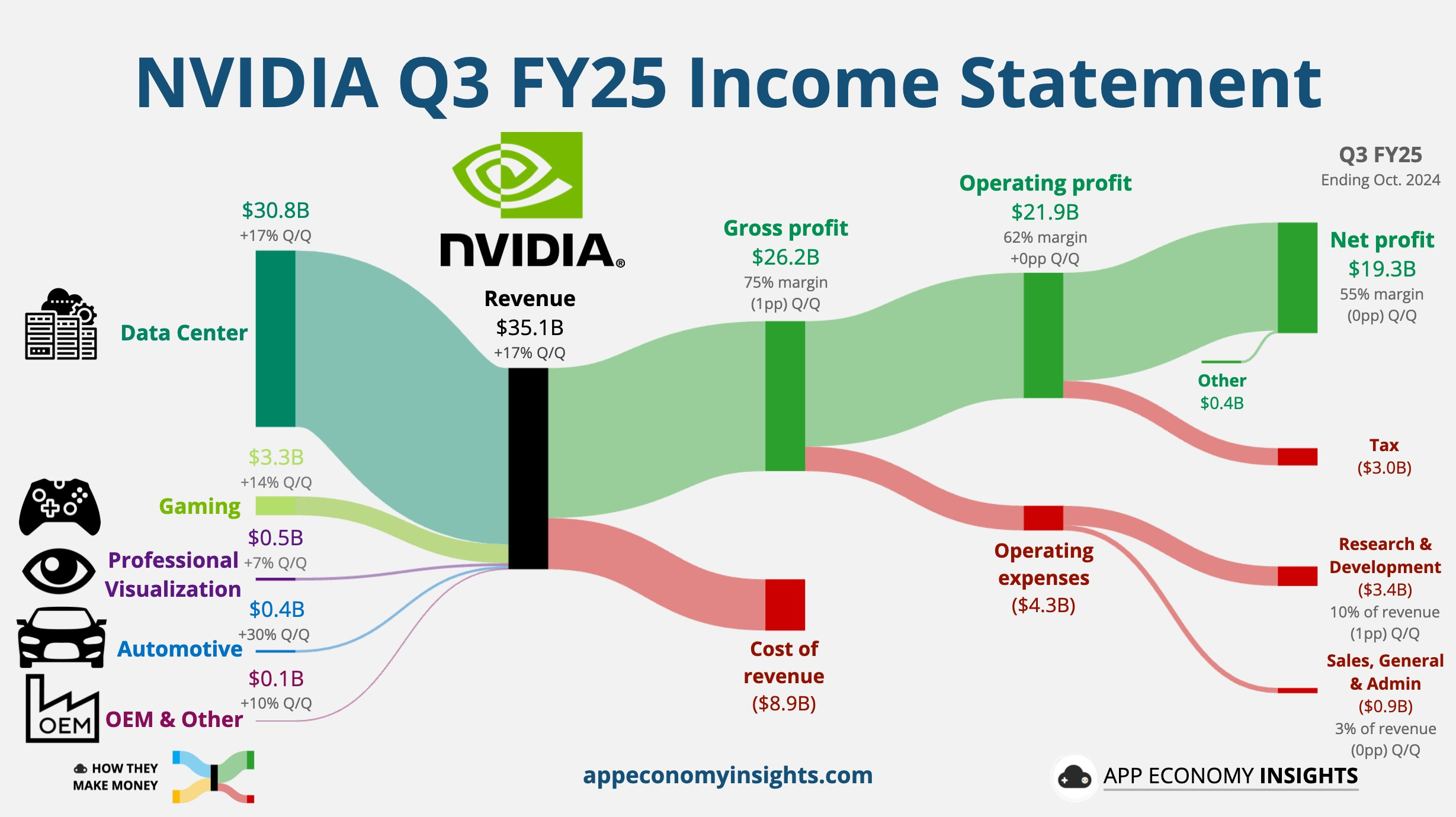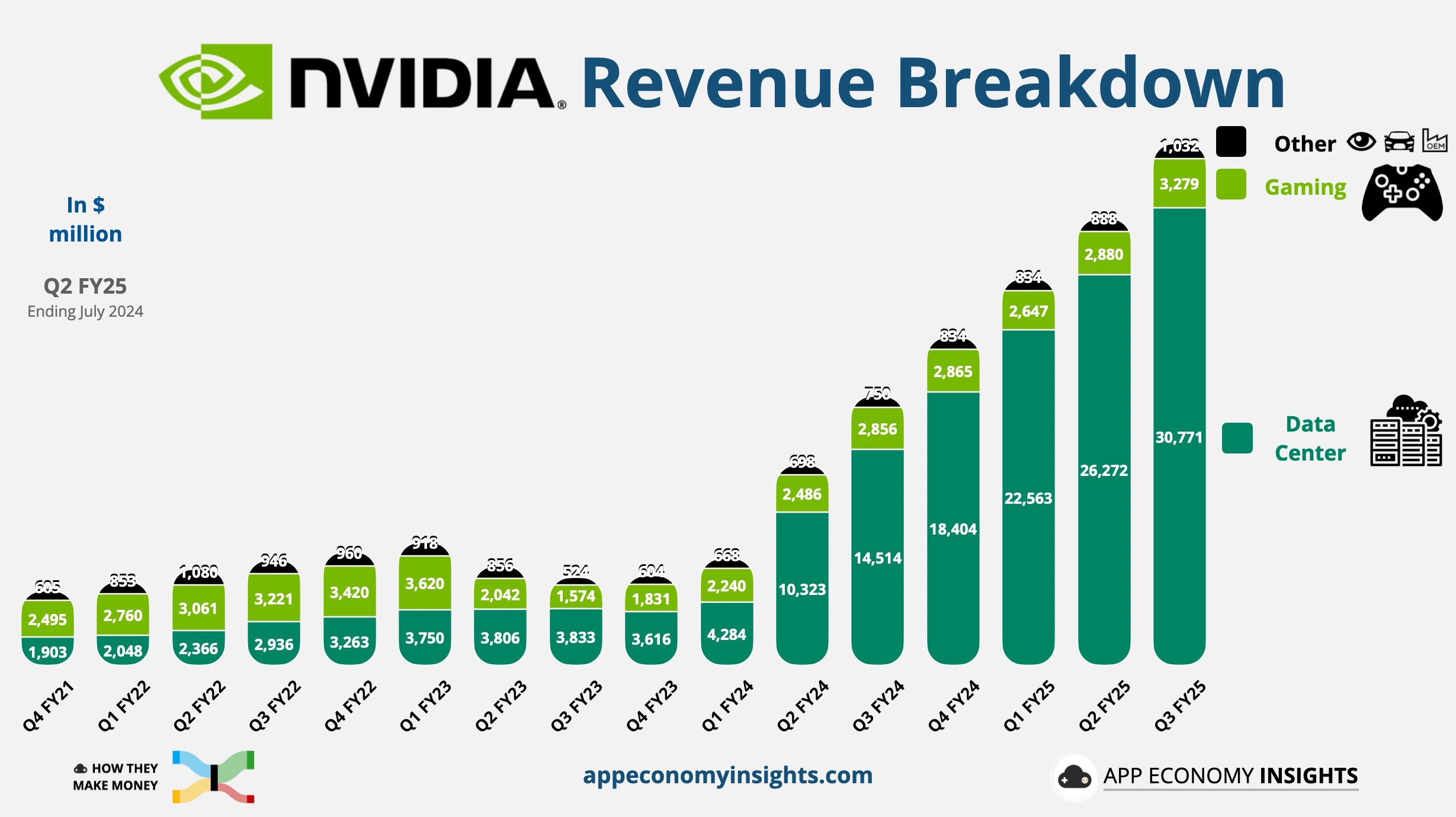$NVIDIA Corp(NVDA)$ reported its fiscal 2025 third quarter results on November 20, 2024 after the bell.Results for the period continued to grow strongly, and continued the momentum of previous quarters, reaching $2 billion (2B) over what the market had been expecting (Consensus), with data centers accounting for nearly 90% of the $30 billion in revenue, and proving that the demand for AI arithmetic remains strong.
But the market is more concerned about the next quarter's guidance.Revenue guidance of $37.5 billion (up or down 2%) was slightly ahead of market expectations of $37.1 billion, falling short of the "huge expectations" of "over $2 billion", while gross margin guidance was flat at 73%, driven byBlackwell volume production drive, and some initial additional costs, as well as Blackwell and Hopper's own gross margin impact, will affect the guidance, close to market expectations.
In the longer term, there is plenty of scope for NVIDIA to address capacity issues, or to raise prices further in the future, and long-term margins remain positive, further supporting the stock.
Financial data overview
Revenue for the third quarter of fiscal 2025 was $35.08 billion, an increase of 94% year-over-year, significantly higher than the consensus estimate of $33.25 billion and ahead of the company's previous guidance of $31.85 billion to $33.15 billion.
On the profit side, adjusted gross margin was 75%, flat year-over-year and also in line with the market consensus estimate, and down 0.7 percentage points sequentially, primarily driven by Hopper and Blackwell products.
Net income was $19,309 million, up 109% year-over-year and 16% sequentially.Adjusted earnings per share (EPS) came in at $0.81, up a whopping 103% year-over-year, again beating analysts' expectations of $0.74.
Performance by Segment
Data centers remain NVIDIA's most important source of revenue, with Q3 revenue reaching $30.8 billion, up 112% year-over-year and well ahead of the consensus estimate of $29.14 billion.
Revenue from the gaming and AI PC business was $3.3 billion, up 15 percent year-over-year, also beating estimates of $3.06 billion.
The professional visualization and automotive and robotics businesses contributed $486 million and $449 million, up 17% and 72%, respectively.
Focus of Investors' Attention
The data center business has been a key driver of NVIDIA's rapid growth in recent years, and its revenue continued to grow more than 100% year-over-year in the quarter, demonstrating continued strong AI demand.
The CFO noted that demand for the Hopper Computing Platform for training and reasoning about Large Language Models (LLMs), recommendation engines, and generative AI applications drove this growth.Cloud providers contribute about 50% of data center revenue, with the rest coming from consumer internet companies.
For investors, concerns about data center performance are focused on the following areas:
Ongoing demand: as AI technology becomes more prevalent, demand for high-performance computing power will continue to drive data center revenue growth.
Competitive Landscape: NVIDIA's leadership in the AI chip market faces challenges from competitors such as AMD, and investors need to pay attention to changes in market share.
Technological innovation: Whether the Hopper platform and the upcoming Blackwell chip can meet market demand and solve technical problems such as overheating will have a direct impact on the company's long-term profitability.
Guidelines
For the fourth quarter of fiscal 2025, NVIDIA expects revenue to be in the range of $37.5 billion, up or down 2%, or $36.75 billion to $38.25 billion, which is higher than the Sell-Side Consensus of $37.1 billion but lower than some buy-side analysts' expectations of $38.8 billion to $41.0 billion (generally up 2B).
Gross margins are expected to be in the range of 73% to 73.5%, essentially in line with Consensus but also below some market expectations.
Market Feedback
After the results were released, NVIDIA's shares fell more than 5 percent in after-hours trading as its fourth-quarter guidance missed top estimates, even though the company's results beat expectations.
Jen-Hsun Huang called demand for Hopper chips and expectations for Blackwell chips "unbelievable," and then the decline narrowed, but the market's uncertainty about future growth remains.
Some investment bank views: nvidia delivered results although "good", but may not be enough to support the current market for its future performance of high expectations.Even if NVIDIA reports slightly better-than-expected numbers, the stock could still run into trouble as traders have high expectations for its future performance.
For now, the market's dissatisfaction with future guidance and uncertainty about the progress of Blackwell chip production are the focus of the recent trading game, and how to balance technological innovation and market demand will be an important factor affecting NVIDIA's stock price and investor confidence.


Comments